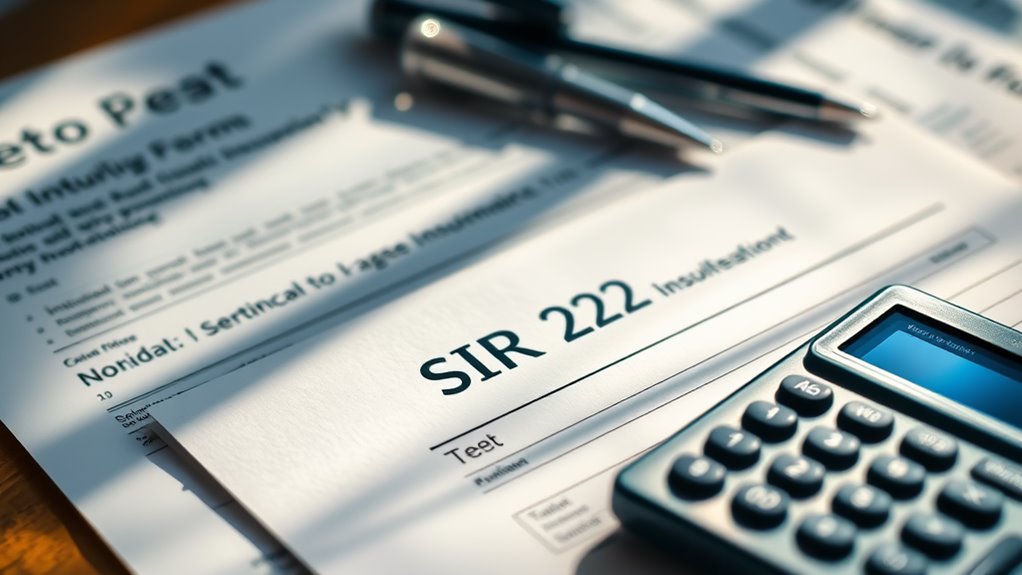What Are SR22 Impact on Premiums Explained?
When you receive an SR22, it signals to insurers that you might pose a higher risk due to previous driving infractions. This can lead to significant increases in your insurance premiums, often by 80% or more. Understanding how this verification affects your rates is essential, especially if you're looking to minimize costs in the long run. But what strategies can you employ to manage these expenses effectively?
When you need to file an SR22, it's essential to understand how it can impact your insurance premiums. An SR22 isn't an insurance policy; rather, it's a form that verifies you have the minimum required insurance coverage. By filing this document, you're signaling to insurance companies that you may be a higher risk. This can lead to increased premiums, especially if you've incurred driving offenses like DUIs or serious traffic violations. The initial filing fee typically ranges from $15 to $100, but that's just the beginning of your financial considerations. Additionally, having a non-owner SR-22 insurance policy can provide you with affordable coverage options if you do not own a vehicle.
The reasons behind your SR22 requirement greatly influence your premiums. For instance, if you need an SR22 due to a DUI, you might see a drastic increase in your rates—sometimes by 80% or more. On the other hand, lesser infractions, like speeding, may not impact your premiums as severely. Your driving history plays a significant role here; past accidents or tickets can raise your premiums as insurers evaluate your overall risk. Additionally, maintaining a clean driving record during the SR-22 period can help lower future insurance costs.
The reasons for your SR22 requirement can significantly affect your insurance premiums, especially with serious offenses like DUIs.
Additionally, factors such as your age and location also come into play. Younger drivers often face higher rates, and those living in urban areas usually see increased costs due to higher accident rates.
The costs associated with maintaining an SR22 can accumulate over time. While the filing fee is a one-time charge, annual premium increases can range from $348 to $1,218, depending on your situation and the severity of your driving offenses. It's important to remember that the SR22 itself doesn't directly cause these rate hikes; rather, it's the circumstances surrounding your need for the form that lead to increased costs, such as driving without insurance, which can result in additional legal expenses.
SR22 requirements generally last between three to five years. Even after the period ends, the impact on your insurance rates can linger. Maintaining a clean driving record during this period can help lower your premiums gradually. Compliance with SR22 conditions is necessary; any lapses in insurance coverage can lead to severe consequences, including license suspension.
To navigate these changes effectively, obtaining quotes from multiple insurance providers is necessary. Each company has different policies in evaluating risk, which can lead to varying premium rates. When comparing quotes, consider coverage limits, deductibles, and available discounts, like those for safe driving.
Some insurers specialize in high-risk drivers and might offer competitive SR22 options, so exploring different insurers is a smart strategy.
Finally, maintaining compliance with your SR22 is essential for avoiding legal repercussions. Timely payments and steering clear of additional violations will help you stay compliant. Keep in contact with both your insurer and the state DMV to confirm you're meeting all necessary requirements.
Understanding your state's specific regulations is significant, as an SR22 only guarantees minimum liability coverage and doesn't equate to full insurance. Remember, continuous coverage is mandatory to protect your driving privileges.
Conclusion
To sum up, the SR22 markedly affects your insurance premiums, often resulting in steep increases due to perceived risks. Think of it as a storm cloud following you; while it may darken your financial outlook initially, maintaining a clean driving record can eventually clear the skies. By staying compliant and cautious on the road, you can navigate through the turbulence and potentially lower your premiums when it's time to renew your policy.
